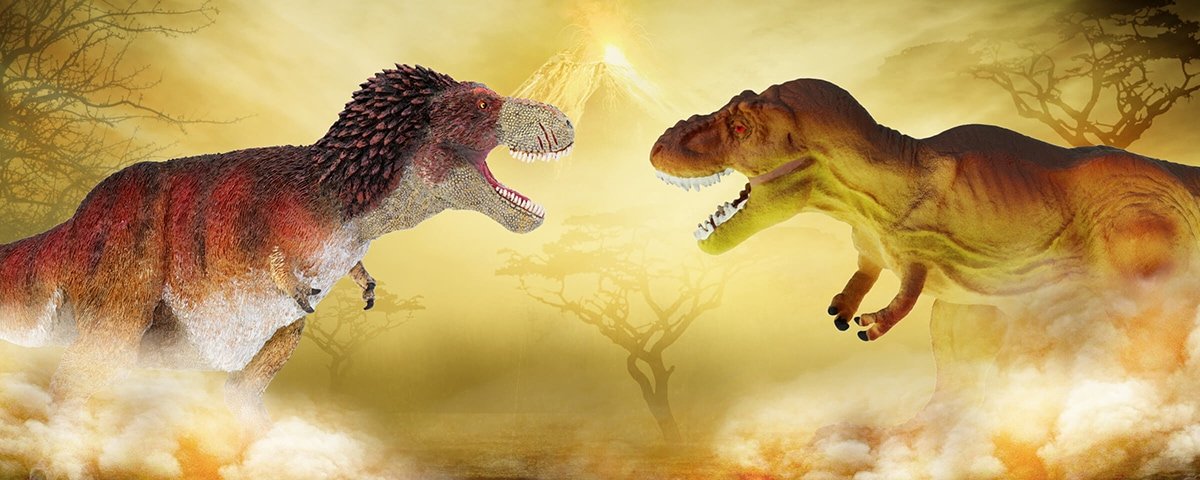There has been a lot of discussion among paleontologists and dinosaur fans recently regarding the Tyrant King of dinos, the Tyrannosaurus Rex…namely, was it covered in scales, like a reptile, or feathers, like a bird? We know that some dinosaurs, including Archaeopteryx, Velociraptor and Microraptor, were covered in feathers. We also know that some, such as ceratopsian dinosaurs like Triceratops, were covered in scales.
How do we know this? While fossilized bones are the most common and familiar dinosaur remains, occasionally paleontologists uncover skin and scale impressions, or even more rarely, evidence of feathers. Sometimes feather impressions are found, and other times structures in the dinosaur’s bones indicate the presence of feathers.
|
|
|
|
(an early feathered dinosaur from the Jurassic Period sometimes called "the First Bird") |
(a dinosaur known to have wing-like feathers on both its arms and legs) |
Where does T-rex fit into all this? As one of the most popular dinosaurs ever, it has been shown countless times in books, comics, toys, movies and cartoons, and up until recently it is almost always shown covered in scales. The idea that it may have had feathers comes as such a shock to so many people that it has sharply divided the dinosaur fandom.
While Safari Ltd has released many scaly Rex toys in its more than 35 years of operation, in 2017 we decided to give a feathered version a shot, in light of some new findings about T-Rex’s relatives. Is this more or less accurate than our scaly versions? As with all reconstructions of dinosaurs, the truth is not as cut and dry as you might think.
|
|
|
Was Tyrannosaurus Feathered? The Fight for Fluffy
What evidence exists in support of T-Rex feathers? Well, it is known for certain that some relatives of Tyrannosaurus were feathered. Dilong and the closely related Guanlong were two somewhat small ancestors of T-Rex from the Early Cretaceous Period. Fossils of Dilong have shown evidence of “Stage 1” feathers, which are basically fine filaments, as opposed to the complex “contour” feathers used for flight that are seen in modern birds. Though it hasn’t been directly discovered, it’s quite likely that Guanlong also had these feathers. It is important to note – the lack of fossil evidence of feathers does not mean that feathers did not exist in life.
However, it’s not such a stretch to believe that smaller dinos – even ones that would eventually give rise to one of the largest predators of all time – were covered in feathers. It can be a bit more difficult to accept that a larger predator like T-Rex was fully fluffed and feathered. That’s where Yutyrannus comes in.

Yutyrannus, showing feathers
Yutyrannus was another T-Rex relative, but unlike the smaller, more slender Dilong, it was much closer in size and proportion to the Tyrannosaurus that most dino-fans are familiar with. Yutyrannus could grow to almost 30 feet in length, and is currently the largest known dinosaur to show direct fossil evidence of feathers.
So, if a large tyrannosaur relative like Yutyrannus was feathered, it stands to reason that T-Rex could have also been both fluffy and ferocious too, right?
Was Tyrannosaurus Scaly? In Support of Scales
But wait, there’s more! We know that Tyrannosaurus Rex had floofy relatives, but there were millions of years between those dinos and T-Rex. Surely it could have lost its feathers in that time, right? Additionally, while scientists haven’t found any direct evidence of feathers on T-Rex, they have found some scaly skin impressions of it and its larger contemporary relatives, including Tarbosaurus, Daspletosaurus, and Gorgosaurus.
Scale impressions are known from the neck, tail, and a few other parts of the dinosaur’s body, and these impressions indicate that at least parts of T-Rex and other larger tyrannosaurs were more reptilian than bird-like in their skin covering. So that would seem to settle it, right? Evidence of scales, coupled with lack of evidence of feathers, means mystery solved: T-Rex was definitely scaly…or was it?
So Was T-Rex Feathered or Scaled? The World May Never Know
As we previously mentioned, the absence of feathers in the fossil record does not mean feathers were not present. Feathers are notoriously hard to preserve, so its possible that any feathers T-Rex may have had simply didn’t last long enough for paleontologists to discover them. According to paleo researcher Dr. Steven Brusatte, preserving feathers takes “inconceivable good luck”, so not seeing feather impressions doesn’t mean they weren’t there.
Additionally, just because T-Rex was scaly in some parts doesn’t necessarily mean it was scaly all over. As paleontologist Dr. Lisa Buckley points out, many birds today are not covered in feathers on every part of their body, and still often have scaly legs and feet. Larger birds, such as vultures and ostriches, have more bare areas on their neck, head and legs, but still have a substantial covering of feathers on much of their bodies. So even if it had scales, it’s possible that T-Rex still had feathers, too.
|
|
|


